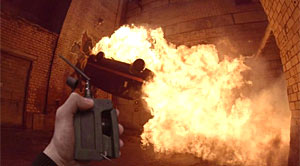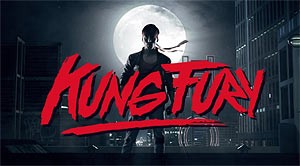Rembrandt’s suspicions prove prophetic as the Lizzies reveal their true motive for why they brought the Warriors back to their clubhouse. The girls lock the clubhouse door and pull out knives and guns. One of the girls confronts Rembrandt accusing the Warriors of killing Cyrus and a battle ensues. The guys barely avoid being shot and Rembrandt is cut on the arm. The three escape by busting through the clubhouse door and sprinting down the street. While hiding in an alley Rembrandt receives minor first aid for his arm from Conchise. Rembrandt tells the other two about how the Lizzies believe the Warriors were responsible for Cyrus’ death. The three head back to Union Square.

Swan arrives at Union Square from the tunnel and is soon shadowed by the leader of the next gang the Warriors will have to face, the Punks. The Punks hang out in the subway dressed in overalls and stripped shirts. Their choice of weapon is not that particular as knives chains and bats are seen in their hands. Snowball and Cowboy arrive at Union Square and meet up with Conchise, Rembrandt and Vermin. After Snowball tells the others about Ajax’s arrest they head out looking for Swan.
Swan is waiting at an arcade inside another part of Union Square with the Punks leader (Konrad Sheehan) and two of his subordinates watching him from close by. Mercy arrives and tells Swan about the Punks of which Swan informs her that he is cognizant of that obvious fact. The two make up.

While Swan and Mercy talk, the other five Warriors arrive. Swan indicates with his eyes to the group that he is being watched. The group acknowledges the situation. Swan points, again with his eyes, towards a mens’ room close by and the gang enters it. By this time, the rest of the Punks members have arrived and they follow the Warriors into the bathroom soon after. They find the room empty. The Punks leader scans the stalls and the rest of the gang arrange themselves in front of each of the enclosures knowing that it’s the only place the Warriors could be hiding.
 The Punks leader opens the first stall’s door and is met with spray paint coming out of a can from Rembrandt. The other stall door bust open and the rumble starts. As before with the Baseball Furies, the Warriors show their superior skill making quick work of the Punks with only Swan receiving any noticeable injury. Swan’s laceration to his left cheek was received while being double-teamed by two of the Punks soldiers.
The Punks leader opens the first stall’s door and is met with spray paint coming out of a can from Rembrandt. The other stall door bust open and the rumble starts. As before with the Baseball Furies, the Warriors show their superior skill making quick work of the Punks with only Swan receiving any noticeable injury. Swan’s laceration to his left cheek was received while being double-teamed by two of the Punks soldiers.

After Swan flips a Punk through the door of a bathroom stall, the fight is over and the Warriors exit the mens’ room taking the next train to Coney Island. They arrive without further incident. The night is over and the sun is rising when the Warriors exit the the train on home turf. But their problems have not all been solved.
The Rogues, who have been searching for the Warriors all night have driven in their beat up hearse to Coney Island. The Rogues, who are responsible for Cyrus’ murder don’t want any of the Warriors alive to tell anyone of their innocence. Swan leads his soldiers to a grandstand near the beach so everyone can get packed. Swan has the switchblade he took from the Punks leader and the others grab what they can find, pieces of wood, pipe, metal and Mercy a smashed bottle.

Now occurs a scene that has become one of the greats in cinematic history and will forever be remembered in the minds of viewers because of David Patrick Kelly’s chilling performance. Kelly would have other minor roles in film, including being one of Arnold Schwarzenegger’s casualties in the action film Commando (he’s the guy Arnold promised to kill last), but none would ever compare to his role of Luther and his acting in this scene particularly.
Kelly made up this scene himself, it wasn’t scripted by director Walter Hill or writer David Shaber. Kelly based it on a thing his neighbor used to say to him when he was a child. The scene I’m speaking of has since been called “Warriors Come Out to Play!” scene as it’s the line Kelly repeats with ascending verbal aggression while clinking three bottles together in his right hand. Here it is for your viewing pleasure:
Warriors Come Out to Play Scene:
After this scene Swan tells his soldiers he will lead the Rogues out onto the sand for a final confrontation. The gang moves to the beach and as predicted the Rogues follow. But Luther has a little surprise in store for the Coney Island natives as instead of fighting Swan one on one as the Warrior’s leader suggests, Luther pulls out his gun and declares that all the Warriors are dead.

Luther points the gun at Swan but Swan avoids the shot and launches the switchblade in his hand toward the Rogues leader. It finds its mark in Luther’s arm and the gun falls to the ground. At that moment a shout of “Riffs” is heard.

The Gramercy Riffs, lead by Masai (Edward Sewer) who took over the largest gang in the city after Cyrus was shot, have also traveled to Coney Island. They were the one’s who put out the word of the Warriors treason to Cyrus’ dream. The Riffs were told of their mistake later in the film by a gang member in attendance at Van Courtlandt Park at the time of the shooting. He informed the Riffs of the Rogues responsibility for the incident and now the Riffs were on the Island to deal out some revenge.

after receiving assurances of their safety from the Riffs leader, the Warriors leave the area by walking further down the beach. Amid Luther’s child like protests and screams, the Riffs deal out their form of justice on the Rogues. The film then jumps to the female DJ, who through her radio program had been keeping all the gangs in New York up to date on the Warriors whereabouts and rumbles as the gang tried to get home. She apologizes on air to the Warriors for the misunderstanding and plays a song for the worn out Coney Islanders. The song, “In the City” sung by Joe Walsh plays while a montage of the Warriors walking along the beach finishes the film.

The Warriors has a director’s cut version of the film where Walter Hill adds comic book effects and an introduction which explains where the inspiration for the film came from (Anabasis by Xenophonhe). The effects just show the cuts from scene to scene in cartoon style in panes like you would see in a graphic novel and adds little to the enhancement of the film. The idea was to further increase the effect that viewers were watching something of fantasy based in a future that didn’t really exist rather than the present day New York of the late ’70s. This would put all the theatrical costumes of the gangs in better context as many might think their display as something foolish if they were trying to represent truthfully the gang culture of the time. If viewed similarly as the costumes worn by the gang led by Malcolm McDowell in Stanley Kubrick’s A Clockwork Orange then you would get the proper feeling Hill was trying to convey.

Either version is great as the film is one of the best action/fight movies in film history. Compare it to films like The Wanderers or Colors and you understand why the film stands out as the best. Romper Stomper is great, so are Gangs of New York and especially City of God, but for a gang film that quits the drama and puts gang culture up front without compromise, nothing is better than The Warriors.
The Warriors Trailer:
The Warriors Deleted Scenes:
The Warriors Gallery:
httpvh://www.youtube.com/watch?v=qSvPwRejIxI




Stay Connected